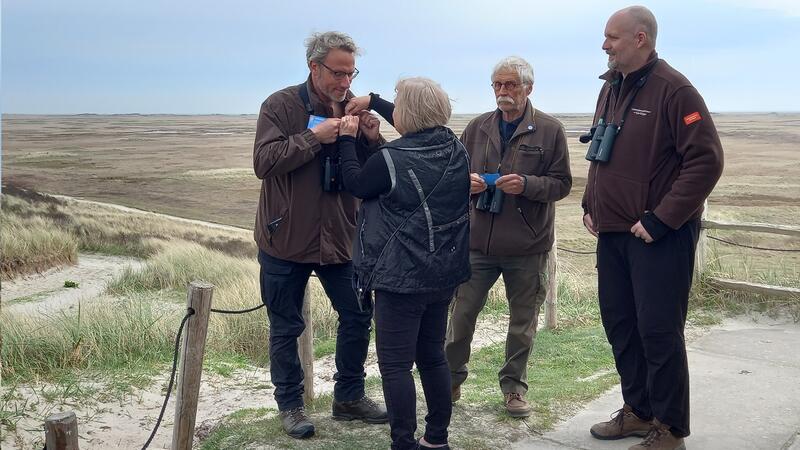Dutch volunteers of Wadden Sea World Heritage honored with UNESCO anniversary badge

On 14 April, Mayor Caroline van de Pol of Terschelling presented a World Heritage badge to three voluntary rangers. This year marks the 50th anniversary of the World Heritage Convention. Participating countries aim to better preserve heritage of unique and universal value to humanity for future generations. In addition to the protection that heritages receive through inclusion on the World Heritage List, this status also promotes mutual understanding between cultures. The Wadden Sea of the Netherlands, Germany and Denmark has been on the list since 2009.
Volunteers carry the World Heritage. The Wadden Sea is managed by many different parties, but they cannot do this without the many volunteers who convert their love for the area into practical action. Think for example of rangers, nature guides, beachcombers and hosts. “There are 160 volunteers for Staatsbosbeheer on Terschelling alone,” says Annelies van der Goot, team leader of Staatsbosbeheer on Terschelling. Voluntary bird warden of the island since 2008, Jan Huneman, adds: “and 120 of them are bird wardens, islanders and wardens from the shore, who together protect this special area and inform visitors”. Unesco Netherlands and the collaborating World Heritage Sites would like to thank these hosts for their efforts to actually implement the Heritage Convention, the protection of the World Heritage Sites. That is why offer a pin with the World Heritage emblem to every volunteer.
Mayor Van de Pol: “I assume that this 50th anniversary will also be commemorated worldwide. And I wonder if, at that commemoration at the Acropolis in Athens, at the Galapagos Islands in Chile and at the Great Barrier Reef in Australia, all of which are also World Heritage Sites, people realize that they can compete with the priceless beauty and the special individuality of the Wadden Sea,” jokes Van de Pol. She then seriously adds: “It is of course clear that we also have something unique, a world class nature area, never forget this. And let's be careful: joint use of the world heritage is good and should be possible, but with respect for all the beautiful and special things that depend on it”. She pins the first three badges on the jackets of the three bird wardens present at the survey station on the Boschplaat. The other, more than a thousand, Wadden Sea volunteers will soon receive the pin. Huneman responds: “we are honoured to receive this on behalf of the hundreds of other volunteers”.
Bird warden Leon Peters enthusiastically explains what their work on the Boschplaat entails in the middle of the World Heritage area: “Together with fellow bird warden Arjen Drost, I am here 24/7, for 7 days. We receive many visitors and talk with them. They listen carefully, not only to our stories about the area and the birds, but also to what is and is not allowed. Fortunately that is going very well.”
The status of World Heritage is due to the unique nature of the Wadden. Sjon de Haan, coordinator of the Wadden Sea World Heritage Site, concludes: “If we want to maintain this status, we cannot do it without volunteers who take responsibility and, above all, spread the story. Together we stand for one Wadden Sea, one World Heritage”.
